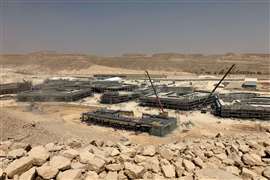Read this article in Français Deutsch Italiano Português Español
Could the power of cosmic rays offer a new way to scan for structural defects?
21 February 2025
A start-up company headquartered in Estonia has developed a method of 3D-scanning using muon flux, which relies on subatomic particles to classify materials and objects. Could it be a game-changer for the industry?
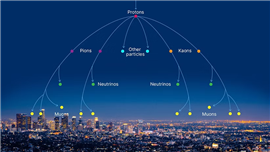 An illustration of how muons move through the atmosphere. (Image: GScan)
An illustration of how muons move through the atmosphere. (Image: GScan)
The company is called GScan, and it believes it has a chance to disrupt the construction 3D-scanning and modelling segments.
The process relies on muons – fundamental and subatomic particles similar to electrons – which are capable of passing through what humans perceive to be solid objects.
The company’s CEO, and one of its early investors, Marek Helm, spoke to Construction Briefing about the futuristic-sounding technology, and looked ahead at what might be next for GScan as it gets a foothold in the construction industry.
More on GScan’s muon flux technology
“Don’t be ashamed!” Helm said to this editor, who struggled to understand the high-tech process during a conversation. “I also didn’t know what muons were before.”
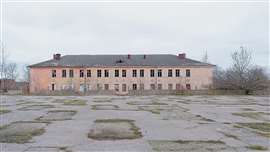 A former Soviet Union structure in Paldiski, Estonia. (Image: Adobe Stock)
A former Soviet Union structure in Paldiski, Estonia. (Image: Adobe Stock)
GScan was founded in 2018, and Helm joined the company as an investor and supervisory board member in 2021. Since then, he’s had ample time to wrap his head around what he calls a revolutionary product and has become adept at translating it for the general public.
“It’s not science fiction, it’s science,” Helm assured. “But, in human language, the muons are small cosmic particles generated 15km above the sea level, penetrating to the ground [at] light speed.”
Helm said the particles are floating through the atmosphere and into the Earth at 2.2 microseconds per lifetime of one million particles. “You are talking per 1m2 per one minute, 10,000 muon particles are going through your body,” added Helm.
He added that GScan developed hardware and software that can capture and analyse muons that have travelled through solid objects. The analysis, Helm said, returns information on what’s inside those objects.
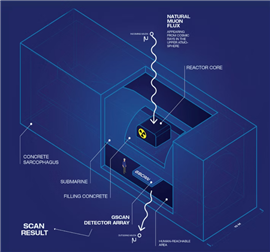 Illustration of the GScan method on the Paldiski, Estonia, nuclear submarine base restoration project. (Image: GScan)
Illustration of the GScan method on the Paldiski, Estonia, nuclear submarine base restoration project. (Image: GScan)
“Basically, muons pass through the upper scanner, then we ‘catch’ the same muons on the lower level of the detector,” Helm explained.
GScan’s tech is able to determine how the muons scattered or altered trajectories during their travel, which in turn allows engineers to rely on the subatomic data to create a model of the scanned object.
“We have a map, or a particle root, and we can draw software, going back through these scattering angles, and through that we can create the image.”
Originally, GScan’s muon flux technology found business by scanning shipping containers, particularly those traversing international borders. But the team has since realised solid applications in construction, infrastructure and civil engineering projects.
How GScan uses muon flux in construction applications
Helm told Construction Briefing that the data from the muons can illustrate what portions of an object are what (concrete, metal, soil), and it can help illustrate if there’s corrosion or gaps.
In particular, Helm said bridges and civil infrastructure are ideal applications for the tech. “This is a game changer in the civil engineering world,” he said.
He continued, “Each location, deep inside a bridge – for example – we are measuring points, and we can go back and understand and measure the chemical composition of any materials on the location there. We can understand if it’s missing a crowning or if there was a void.”
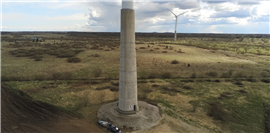 GScan works on using muon flux to scan a windmill. (Image: GScan)
GScan works on using muon flux to scan a windmill. (Image: GScan)
One highly unique project GScan worked on was a reclamation project at a former Soviet Union nuclear submarine training centre in Paldiski, Estonia. The nuclear sub hub was once the largest of its type in the world.
“Thirty years ago, the Russian military troops left, and before they did, they put all the nuclear waste inside and filled it with concrete,” explained Helm. “And the [Estonian] government didn’t have any idea where the reactors are located, what waste is there, et cetera.
“We put our scanners below the [nuclear] sarcophagi and slice it with 1mm resolution, giving the exact 3D image.”
Helm said with the information, the requisite demolition and recycling experts tasked with cleaning up the site were able to make informed and safer decisions.
What’s next for GScan and muon flux?
GScan was one of eight finalists in the Cemex Ventures Startup Competition at Trimble Dimensions 2024, though the firm fell just short of taking home a medal.
Helm admitted that the US market (where Dimensions is held annually) is not likely to be one of the next GScan enters due to its size, but he said they’ve been engaged in conversations with the UK’s National Highways department, which GScan has worked with in the past (the firm has an office in Cambridge, England). He said there could be possibilities in Germany, too, where the company has also opened a satellite office in Munich.
 Marek Helm, GScan CEO
Marek Helm, GScan CEO
Helm said GScan is taking a slowly-but-surely approach to expansion, as he recognises civil infrastructure technology can be a tough segment to crack into.
“The civil engineering world is very conservative. Everyone wants to test and validate,” he said. “And we’re not saying that we are replacing current technologies; we’re just adding one very valuable dataset to these existing tools.”
STAY CONNECTED



Receive the information you need when you need it through our world-leading magazines, newsletters and daily briefings.
CONNECT WITH THE TEAM











